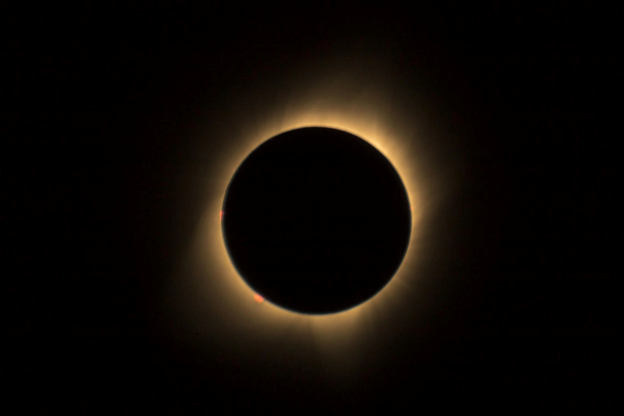In the world of celestial events, few moments rival the sublime spectacle of a solar eclipse. On April 8th, a Total Solar Eclipse will cross North America, passing over many cities. For dedicated eclipse hunters, the thrill of witnessing the sun disappear behind the moon, casting an ethereal shadow upon the Earth, is a culmination of months—if not years—of anticipation and meticulous planning. Picture the scene: you've identified the optimal time and location to witness the celestial spectacle of totality. As the moon slowly creeps across the face of the sun, the world around you transforms, with shadows shifting and the horizon ablaze in a breathtaking sunset. All that stands between you and a healthy experience taking in the eclipse is the simple act of donning your solar eclipse glasses as eye protection.

Total eclipse photo by Drew Rae from Pexels
Is it safe to look at the sun without eye protection? The answer is unequivocally no.
If one looks at the sun without eye protection, there are risks of permanent vision loss, known as solar retinopathy, best prevented by wearing eclipse glasses. Even a brief exposure, less than a minute, to a solar eclipse without protection can result in permanent decreased visual acuity, typically manifesting as a central visual field defect called a scotoma. Solar retinopathy may also lead to symptoms such as blurry vision, straight lines appearing wavy or distorted, objects seeming smaller than their actual size, and difficulty perceiving colors accurately. In addition to the visual changes, solar retinopathy may also cause photophobia and headaches. The diagnosis is confirmed by a full ophthalmology assessment in the days following the eclipse. Risk factors for solar retinopathy include young age, having a clear intraocular lens, taking photosensitizing drugs such as tetracyclines and psoralens, and individuals with mental impairment, psychiatric disease, or under the influence of cognition-altering drugs.
Solar retinopathy occurs due to excessive light energy harming the fovea region within the macula at the back of the eye. The retina does not have pain receptors to signify impending visual damage. This damage can be likened to using a magnifying glass to focus sunlight and burn an object, except in this case, the cells in the back of your eyeball are affected. Alternatively, this can be akin to “getting a sunburn on the back of your eye”. While gazing too long at the sun during a solar eclipse is a classical example of this type of damage, welding arcs, laser pointers, and specialized microscopes can also result in light-induced harm to the back of the eye.
To date, there is no known treatment for solar retinopathy. Visual acuity is expected to gradually improve over 3-6 months, although some people may suffer permanent vision loss.
To prevent solar retinopathy, one must wear eye protection outdoors when attempting to look at the sun. The glasses must include solar filters that meet the ISO 12312-2 standard for macular protection when viewing the sun or eclipse. Typical UV-protective sunglasses do not meet these standards. The American Astronomical Society has prepared information confirming the safety of solar eclipse glasses, as well as a list of suppliers that meet the ISO 12312-2 safety standard. Confirm any eclipse eye protection is purchased from a reputable retailer.
It is essential to familiarize yourself with eclipse solar filters before the eclipse occurs, which may be either glasses or handheld solar filters. To confirm the solar filter eye protection is safe, you should only be able to see the sun, not any household lamps or smartphone screens when looking through the filter. The filter should be in working condition, without tears, scratches, punctures, or gaps between the edges of the lenses and frames. In the event eclipse glasses or a handheld solar filter are not available or are damaged, a pinhole projection could be used, but this still requires avoiding looking directly into the sun. Although tempting to take a “sneak peak” without eye protection, the only time one can safely look towards the sun during the eclipse without eye protection is during totality, the up to 4.5-minute interval when the moon completely blocks the sun. If eye protection is faulty or damaged or one removes eye protection outside the window of eclipse totality, there is an increased risk of vision damage.
While watching the eclipse, use protective eyewear to protect your eyes from solar retinopathy and form a plan for a safe eclipse experience. If vision damage is suspected following an eclipse, one should seek care in the days following the eclipse with an Ophthalmologist, who can perform an exam to visualize damage to the eye. Emergency evaluation is not necessary as standard radiography and echography will be normal. An eclipse is a natural wonder but one best experienced with planning and vision precautions.